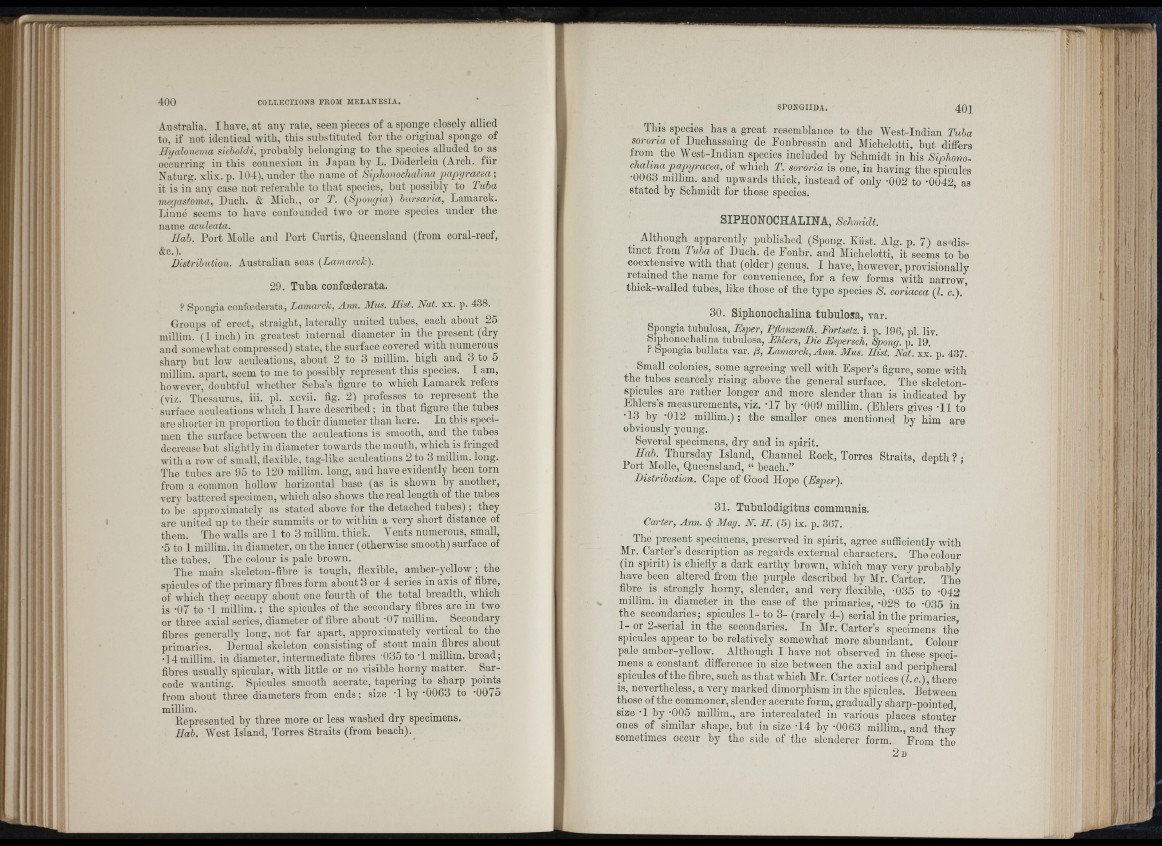
Australia. I have, at any rate, seen pieces of a sponge closely allied
to, if not identical with, this substituted for tho original sponge of
Ilyalonema sieholdi, probably belonging to the species^ alluded to as
occurring in this connexion in Japan by L. Doderlein (Arch, für
Naturg. xlix. p. 104), under tho name of SipJionoclialina papifracea ;
it is in an}' case not referable to th a t species, but possibly to Fuha
megastoma, Duch. & Mich,, or T. (Spiongia) biirsana, Lamarck.
Liiine seems to have confounded two or more species under the
name acideata.
Hab. Port Molle and Port Curtis, Queensland (from coral-reef,
&c.).
Distrihution. Australian seas (Lamarch).
29. Tuha confoederata.
? Spongia confoedei’ata, Lamarck, Ann. Mus. Hist. Nat. xx. p. 438.
Groups of erect, straight, laterally united tubes, each about 25
millim. (1 inch) in greatest internal diameter in the present (dry
and somewhat compressed) state, the surface covered with numerous
sharp but low aculeations, about 2 to 3 millim. high and 3 to 5
millim. apart, seem to me to possibly represent this species. I am,
however, doubtful whether Seba’s figure to which Lamarck refers
(viz. Thesaurus, iii. pi. xcvii. fig. 2) professes to represent the
surface aculeations which I have described ; in th at figure the tubes
are shorter in proportion to their diameter than here. In this specimen
the surface between the aculeations is smooth, and the tubes
decrease but slightly in diameter towards the mouth, which is fringed
with a row of small, flexible, tag-like aculeations 2 to 3 millim. long.
The tubes are 95 to 120 millim. long, and have evidently been torn
from a common hollow horizontal base (as is shown by another,
very battered specimen, which also shows the real length of the tubes
to be approximately as stated above for the detached tubes) ; they
are united up to their summits or to within a very short distance of
them. The walls are 1 to 3 millim. thick. Vents numerous, small,
•5 to 1 m i l l im . in diameter, on tho inner (otherwise smooth) surface of
the tubes. The colour is pale brown.
The main skeleton-fibre is tough, flexible, amber-yeUow the
spicules of the primary fibres form about 3 or 4 series in axis of fibre,
of which they occupy about one fourth of the total hreadth,^ which
is -07 to -1 millim.; the spicules of the secondary fibres are in two
or three axial series, diameter of fibre about ’07 millim. ^ Secondary
fibres generally long, not far apart, approximately vertical to the
primaries. Dermal skeleton consisting of stout main fibres about
•14 millim. in diameter, intermediate fibres '035 to -1 millim. broad;
fibres usually spicular, with little or no visible horny matter. Sarcode
wanting. Spicules smooth acerate, tapering to sbarp points
from about three diameters from ends; size -I by -0063 to -0075
millim.
liepresented by three more or less washed dry specimens.
Hah. West Island, Torres Straits (from beach).
SPONGIIDA. 401
This species has a great resemblance to the West-Indian Tuba
sororia of Duchassaing de Fonhressin and Michelotti, but differs
from the West-Indian species included by Schmidt in his Siphono-
chahnu papyracea, of which T. sororia is one, in having the spicules
•0063 milhm. and upwards thick, instead of only -002 to -0042, as
stated by Schmidt for those species. ’
SIPHONOCHALINA, Schmidt.
_ Although apparently published (Spong. Kiist. Alg. p. 7) as distinct
from Tuba of Duch. de Fonbr. and Michelotti, it seems to be
coextensive with th at (older) genus. I have, however, provisionally
retained the name for convenience, for a few forms with narrow,
thick-waUed tubes, like those of the type species S. coriacea (I. c.). ’
30. Siphonochalina tnhulosa, var.
Spongia tubulosa, Esper, Pflanzenth. Eortsetz. i. p. 196, pi. liv.
Siphonochalina tubulosa, Ehlers, Die Espersch. Sqoong. p. 19.
P Spongia hullata var. ¡3, Lamarck, Ann. Mus. Hist. Nat. xx. p. 437.
Small colonies, some agreeing well with Esper’s flgurc, some with
the tubes scarcely rising above the general surface. The skeleton-
spicules are rather longer and more slender than is indicated by
Ehlers's measurements, viz. -17 by -009 millim. (Ehlers gives -11 to
•13 by -012 millim.); the smaller ones mentioned by him are
obviously young.
Several specimens, dry and in spirit.
Hab. Thursday Island, Channel Eock, Torres Straits, depth ? :
Fort Molle, Queensland, “ beach.”
Distribution. Cape of Good Hope {Espei).
31. Tuhnlodigitus commnnis.
Carter, Ann. ^ Mag. N. H. (5) ix. p. 367.
The present specimens, preserved in spirit, agree sufiiciently with
Mr. Carters description as regards external characters. The'colour
(in spirit) is chiefly a dark earthy brown, which may very probably
have been altered from the purple described by Mr. Carter. The
fibre is strongly horny, slender, and very flexible, -035 to -042
millim. in diameter in the case of the primaries, -028 to -035 in
the secondaries; spicules 1- to 3- (rarely 4-) serial in the primaries,
1 - or 2-serial in the secondaries. In Mr. Carter’s specimens the
spicules appear to be relatively somewhat more abundant. Colour
pale amber-yellow. Although I have not observed in these specimens
a constant difference in size between the axial and peripheral
spicules of the fibre, such as th at which Mr. Carter notices (I.e.), there
is, nevertheless, a very marked dimorphism in tho spicules. Between
those of the commoner, slender acerate form, gradually sharp-pointed,
size •! by '005 millim., are intercalated in various places stouter
ones of similar shape, but in size -14 by -0063 millim., and they
sometimes occur by the side of the slenderer form. From the
2 d
j /
5'". !